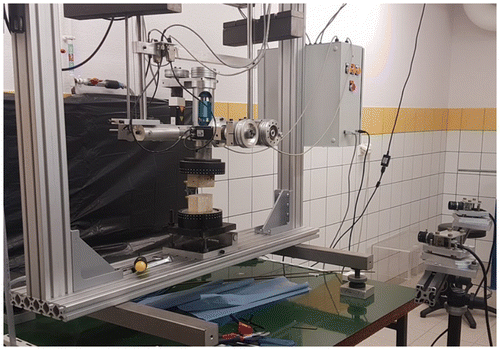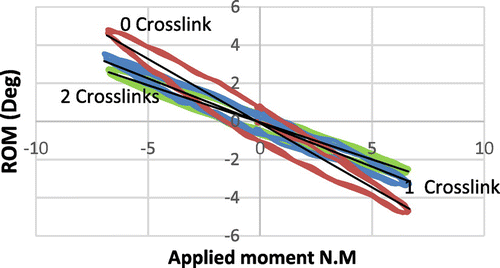1. Introduction
Percutaneous techniques were initially developed in the management of thoraco-lumbar fractures. Initially transmucular systems have been developed, which generally provide less muscle trauma, blood loss and surgical time. They also benefit from a reduction in the duration of hospitalization, a lower rate of infection, and a reduction in postoperative pain. Nevertheless, there is no system of crosslink binding in these minimally invasive approaches, and those, which are vectors of pain and discomfort from a clinical point of view (Skovrlj Citation2015). Crosslinks are often used clinically as part of spinal instrumentation, but relatively little basic biomechanical research has been done in terms of their contribution. Dick et al. (Citation1997) used a synthetic spine of polyurethane and reported that stiffness with the concomitant use of transverse systems increased by 60% in axial rotation, but that no increase in flexion, extension or lateral inclination were Observed. Conversely, Lynn et al. (Citation1997) performed cadaveric biomechanics showing that concurrent use of crosslinks increased stiffness not only in rotation but also in lateral flexion. Our study aims to determine the contribution of one or two transverse devices in a short assembly, for which the results are very variable in the literature and if it is necessary to develop percutaneous.
2. Methods
Wood model of T11-L2 vertebrae were home made and extremities are embedded in rigid polyurethane resin. Then we put 4 pedicle screws (6.5–45 mm Sofamor Danek Medtronic®) and 5.5 mm connective rods, and CD HORIZON® X10 CROSSLINK. To reproduce physiological loadings on specimens, a specific spinal loading simulator has been employed. With this setup, spinal specimens have been tested in flexibility from pure moment loadings according to one of the three physiological axis (sagittal, frontal or transverse) and were allowed to move unconstrained in the five uncontrolled degrees of freedom (free translations and rotations). To measure mobility of each vertebra of the specimen during the loading, 3D mark tracking technique was used (Germaneau et al. Citation2016). This stereoscopic optical method consisted in tracking marks deposed on the vertebra, allowing the measurement of mobility of each vertebra of the segment. The range of motion (ROM) between two adjacent vertebrae according to imposed moment and according to fixation type could be analysed.
3. Results and discussion
Figure shows angle variation measurement in axial rotation loading for a pure moment up to 7.5 Nm. A difference in the rotation angle was found with the use of one or two crosslinks. One crosslink was 31% stiffer in torsion than nothing was, and two crosslinks construct 43% stiffer. Angle variation remains strictly similar in flexion extension and bending between none, one or two crosslinks.
Brodke et al. (Citation2001) reported the effects of transverse connections with increased lateral flexural rigidity. However, Hart et al. (Citation2006) examined the porcine vertebral column and reported that the effect of concomitant use of was observed not only in lateral flexion and axial rotation but also in flexion and extension. Wahba et al. (Citation2010), Lazaro et al. (Citation2011), and Wang et al. (Citation2013) conducted biomechanical experiments using human vertebrae and reported no effect of flexion, extension, or lateral flexion connectors, while significant effects on rotation were noted. As for using 2 crosslinks instead of one, Dick et al. (Citation1997) have reported that a 26% increase in rotational movement, in addition, Wang et al. (Citation2013) demonstrate with concomitant use of crosslinks significantly increased rotational stiffness. Lim et al. (Citation2001) also reported that the concomitant use of two crosslink was effective in significantly increasing the rotational stiffness. According to the results of our study, the use of two crosslinks resulted in a significant increase in axial stiffness. Moreover, from a mathematical point of view, a greater rotational rigidity is obtained by increasing the separation of the assembly, which we have not tested. It would be useful in the future to compare the effect of crosslinks on the wear resistance at the level of the screws, as, as we have seen, this limits the flexibility of the rods, has studied its contribution in arthrodesis surgeries for which it would be interesting to continue the research.
4. Conclusions
This work presented an original study on the mechanical behaviour of spine stabilisation system by imposing pure moment loadings. Experiments leaded with a demonstrator spine model by considering a robust anchorage of the screws provided data on the mechanical response and the mobility associated to rods with or without crosslinks.
In this wood spine model fracture in pure loading, two crosslink provided more torsional stiffness but have no effect in flexion or bending moment. Future works must be performed to complete these preliminary results in particular with experiments on cadaveric specimens to add tests with different screw anchorages.
References
- Brodke DS, Bachus KN, Mohr RA, Nguyen BK. 2001. Segmental pedicle screw fixation or cross-links in multilevel lumbar constructs. a biomechanical analysis. Spine J. 1:373–379.
- Dick JC, Zdeblick TA, Bartel BD, Kunz DN. 1997. Mechanical evaluation of cross-link designs in rigid pedicle screw systems. Spine. 22:370–375.
- Germaneau A, Vendeuvre T, Saget M, Doumalin P, Dupré JC, Brémand F, Hesser F, Couvertier M, Brèque C, Maxy P, et al. 2016. A novel approach for biomechanical spine analysis: mechanical response of vertebral bone augmentation by kyphoplasty to stabilise thoracolumbar burst fractures. J Mech Behav Biomed Mater. 59:291–303.
- Hart R, Hettwer W, Liu Q, Prem S. 2006. Mechanical stiffness of segmental versus nonsegmental pedicle screw constructs: the effect of cross-links. Spine. 31:E35–38.
- Lazaro BCR, Deniz FE, Brasiliense LBC, Reyes PM, Sawa AGU, Theodore N, Sonntag VKH, Crawford NR. 2011. Biomechanics of thoracic short vs. long fixation after 3-column injury: laboratory investigation. J Neurosurg: Spine. 14:226–234.
- Lim TH, Kim JG, Fujiwara A, Yoon TT, Lee SC, Ha JW, An HS. 2001. Biomechanical evaluation of diagonal fixation in pedicle screw instrumentation. Spine. 26:2498–2503.
- Lynn G, Mukherjee DP, Kruse RN, Sadasivan KK, Albright JA. 1997. Mechanical stability of thoracolumbar pedicle screw fixation. The effect of crosslinks. Spine. 22:1568–1572; discussion 1573.
- Skovrlj B. 2015. Minimally invasive procedures on the lumbar spine. World J Clin Cases. 3:1.
- Wahba GM, Bhatia N, Bui CNH, Lee KH, Lee TQ. 2010. Biomechanical evaluation of short-segment posterior instrumentation with and without crosslinks in a human cadaveric unstable thoracolumbar burst fracture model: spine. 35:278–285.
- Wang Z, Sakakibara T, Yoshikawa T, Inaba T, Kasai Y. 2013. Do the position and orientation of the crosslink influence the stiffness of spinal instrumentation? J Spinal Disorders Tech.


